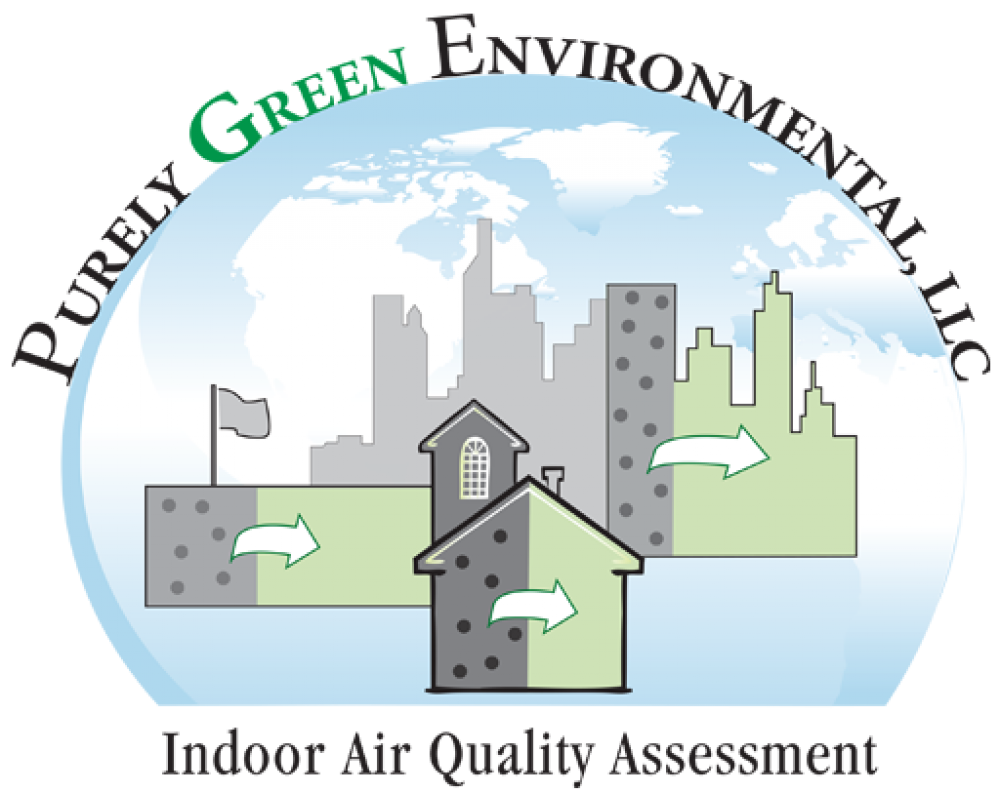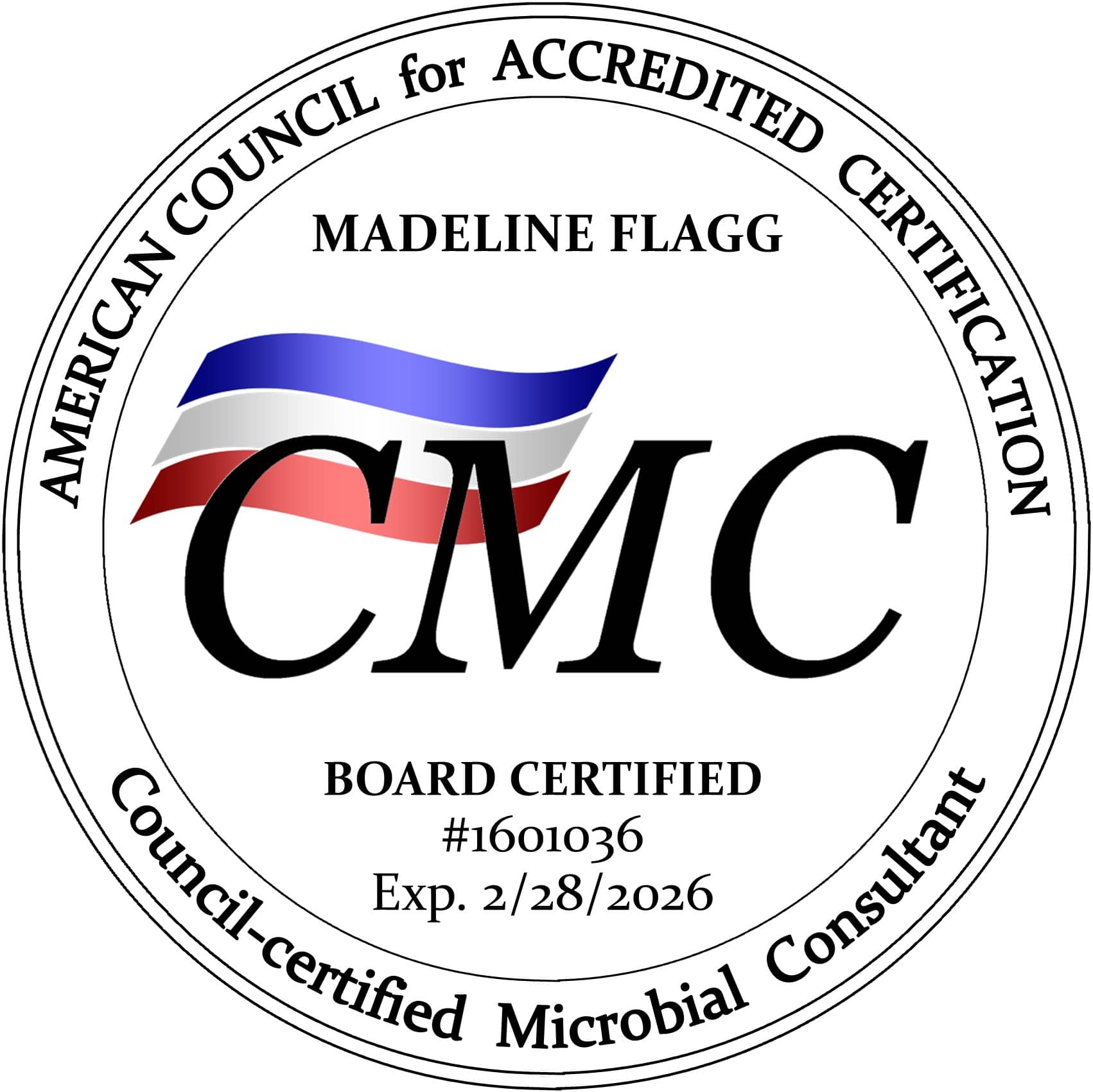Inspection Data Collection and Analysis: Instrument and Assessment Tools
- Microbiological Assays – Air samples, as well as surface samples with cultured swabs, non-viable biotape lifts and bulk materials, will be used as deemed appropriate based on our professional experience. Samples are analyzed by an environmental microbiologist at an AIHA (American Industrial Hygiene Association) accredited environmental laboratory. We typically run nonviable air tests called spore traps as they provide a broad spectrum of mold spores. Indoor air samples are analyzed in comparison to an Outdoor Baseline Sample so that sound conclusions can be made. Besides collecting intact mold spores, spore trap testing can also be used to identify hyphal fragments, pollen grains, textile fibers, human skin flakes, and plant hairs that may be airborne. We also offer an expanded particle analysis as an option that provides a more comprehensive breakdown of dust components such as gypsum, insect parts, silica, dander, cellulose synthetics fibers, talc, dust mites, pollen, fiberglass, combustion by-products (soot from furnace, candle or kerosene heater, wood ash). When necessary, we are equipped to draw wall cavity samples when there is reason to suspect mold growth within walls/ceilings. This sample will be compared to a baseline wall cavity sample in an area that has not experienced water intrusion so that sound conclusions can be made. Wall cavity samples are obtained by drilling a one-inch hole into the drywall and inserting a special tube to draw air from the wall cavity using our Zefon BioPump. After obtaining the sample, the hole is sealed with heavy-duty painter’s tape as we do not repair the wall with plaster. (view a Hayes Microbial Consulting Sample Lab Report).
- Wagner Moisture Reader B1 2200 – Moisture Meter readings are a valuable parameter to our understanding of the indoor environment. We use a non-penetrating meter designed to recognize the moisture content of construction materials. This tool pinpoints water-laden surfaces that are not visually wet or wet to the touch. A Moisture Reading of 17% or higher helps us determine the drywall is holding moisture (using the 0:50 scale on the meter). The highest reading of 32% indicates the object is very wet, just like it would read in a puddle of water. Please note: this is a relative measurement and a baseline of the same material should be determined in dry spots to get a fair comparison. Typical drywall can read anywhere from 0-8% in places where no water intrusion has occurred. We can imply from any reading over 17%, that this damp condition can support mold growth and so there is a high probability of microbial contamination on the inner side of the drywall if this wall has been “wet” for more than 48 hrs.This a legitimate reason to recommend remediation because sanitizing the room will only affect the interior surfaces. If the underside of drywall is really wet, it makes sense that the only solution is to remediate by removing drywall, followed by treating the inner cavity and studs with safe biocides and HEPA vacuuming. Unfortunately, when mitigation companies cut just enough drywall to allow a fan to accelerate the drying process in this wet area, mold that is already proliferating can spread more readily creating heightened unhealthy air quality.
- Zefon BioPump ZBP-100 – This special air pump has a flow rate of 15 liters/minute of air and deposits airborne particulate on a sterile spore trap that will be analyzed by a certified environmental microbiologist.
- FLIR E30 Infrared Thermal Imaging Camera – An infrared camera gives us valuable information to pinpoint temperature fluctuations that may be related to water intrusion or poor insulation. We use this device to screen areas that may be suspect and then we rely on our Moisture Reader to further investigate potential areas of water intrusion.
- FLIR Extech Video Boroscope/Wireless Probing Camera (BR200) – to examine areas above ceiling tiles or other hard-to-reach places as well as checking interior wall cavities made accessible by drilling a small one-inch diameter hole into the drywall.
- DC1700 Laser Particle Counter – Provides real-time measurement of airborne particulates in the 0.5um / 2.5 um range. This is another helpful screening tool to decide the best places to take air samples. Small particles that are 0.5 microns or larger include mold spores, bacteria, fibers, fine dust, smoke, etc. Larger particles that are 2.5 microns or larger include course dust, pollen, larger bacteria, plant spores, dust mite feces, dander, and some larger mold spores.
- Extech Relative Humidity/Temperature/CO2 Datalogger (SD800) and Extech CO Monitor (CO10) – Excessive humidity can create poor indoor air quality as it can promote mold proliferation just as severe as a flood can cause. Therefore this is an important part of our air quality assessment.
- VOC/MVOC Tests Prism Analytical Pumps (Model HAC-100 Air Sample Pump with Flow Rate: 200 mL/min) and Thermal Desorption Tubes (Prism AS0002) – This is an optional way to analyze the air with an AIHA (American Industrial Hygiene Association) accredited environmental laboratory by means of a chemical profile that will identify a wide spectrum of volatile organic chemicals and hidden viable mold off-gassing that may be present in a building. These tests provide us with common building materials and lifestyle sources of the contamination we uncover. (view Prism Sample Lab Report) Tri-matrix thermal desorption tube collects polar and non-polar chemicals such as the following classes of compounds found in Quantitative List A and Semi-Quantitative List of Prism Technical Bulletin 503 rev 15 (click here to view): C-3 through C-14 Hydrocarbons; C-1 to C-14 alcohols, amines, sulfides, aldehydes, ketones, esters, ethers (solvents, odorants, & stinkers); Aromatics (gasoline and fuels); Halogenates (industrial solvents); Terpenes (pine and citrus); Paint VOCs; Mold VOCs. Formaldehyde and other compounds listed on Quantitative List B and C (outside of the routine chemical profiles) are available upon request.
- Formaldehyde Testing – Formaldehyde is a colorless, strong-smelling gas often found in aqueous (water-based) solutions. Commonly used as a preservative in medical laboratories and mortuaries, formaldehyde is also found in many products such as chemicals, particleboard, household products, glues, permanent press fabrics, paper product coatings, fiberboard, and plywood. It is also widely used as an industrial fungicide, germicide, and disinfectant. Formaldehyde is a sensitizing agent that can cause an immune system response upon initial exposure. It is also a cancer hazard. Acute exposure is highly irritating to the eyes, nose, and throat and can make anyone exposed cough and wheeze. Subsequent exposure may cause severe allergic reactions to the skin, eyes, and respiratory tract. Ingestion of formaldehyde can be fatal, and long-term exposure to low levels in the air or on the skin can cause asthma-like respiratory problems and skin irritation such as dermatitis and itching. Concentrations of 100 ppm are immediately dangerous to life and health (IDLH). Note: The National Institute for Occupational Safety and Health (NIOSH) considers 20 ppm of formaldehyde to be IDLH.1The analytical test method used by Prism for gaseous formaldehyde or for formaldehyde in water has been correlated or is compliant with the California Air Resources Board’s (CARB) § 93120, European DIN Standard EN-717, and ASTM methods D-5582 and E-1333. It has also been compared with DNPH testing used in NIOSH 2016 and found to be in good agreement.2Ambient air sampling is done with our A14 formaldehyde sorbent tube and a 200 mL/min air pump. The minimum detection limit for formaldehyde is one of the complicating factors in formaldehyde investigations is the variety and number of sources. There are a surprising number of sources in various building materials, everyday products, and natural processes.
The largest source of formaldehyde in homes is from resins used in adhesives and binders in engineered wood products such as particleboard, plywood, medium density fiberboard (MDF), and oriented strand board (OSB) as well as more wood finished products like engineered flooring. Other building products, such as insulation, glues, and adhesives, and paints and coatings may also contain formaldehyde. There are also a variety of non-building products that contain formaldehyde such as:- cleaning products
- soaps
- preservatives
- cosmetics
- textiles (e.g., permanent press fabrics)
- air fresheners
- pet care products
- bactericides and fungicides
Formaldehyde is also present in combustion processes, including tobacco and wood smoke and fuel-burning appliances such as gas stoves, kerosene space heaters, and fireplaces. Formaldehyde Commercial Sample Report
See Why You Should Test Your Air For Formaldehyde with IAQ Home Survey™
- ERMI stands for the Environmental Relative Moldiness Index – This is a supplemental method to screen homes for mold contamination with an AIHA (American Industrial Hygiene Association) accredited environmental laboratory. Based on recently published data from EPA researchers and the 2006 HUD American Healthy Home Survey, the test was developed as a tool to evaluate the potential risk of indoor mold growth and associated health effects. In some instances, physicians are looking for specific information based on DNA analysis (requires collecting dust from a home) rather than morphology as with standard microbiological analysis. We offer this as an option when called for.




